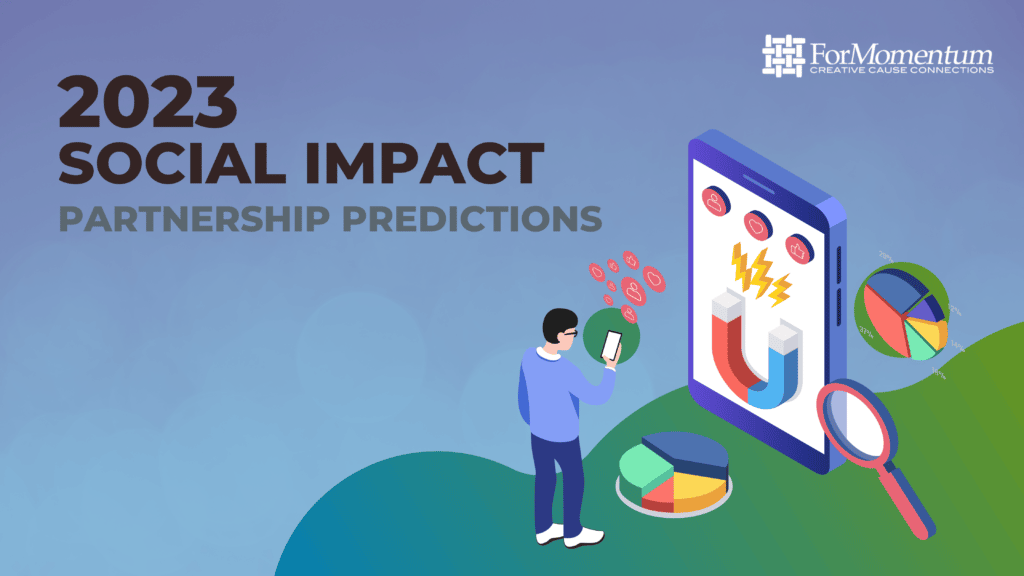By: Mollye Rhea
Cause partnerships and social impact strategies have shifted significantly since the pandemic took over the world almost three years ago. Last year, we saw focus shift toward employees as a top audience, JEDI initiatives rise to the top of corporate priorities and an increase in ESG expectations.
We can’t guarantee what is in store for 2023, but as an agency celebrating our 20th year in business developing hundreds of social impact partnerships, we can share informed predictions straight from our recent experiences.
Below are key trends we see shaping the partnership space in 2023.
An economic slowdown will force pivots in partnership strategies, activations and priorities.
Economic conditions are impacting corporate success rates, and therefore will influence their strategies. For example, Morning Consult’s 2022 fastest growing brands list saw more products with low price points topping the list, such as food & beverage items and cost-saving alternatives in several sectors. According to a report by Placer.ai, the discount and dollar retail sector outperformed other categories as shoppers are seeking low-cost options. This is translating into shifting priorities and strategies for companies to remain relevant and to attract and retain customers. Some economy-influenced changes we predict for partnership include:
- Knowing that consumers are struggling with decreasing budgets and increasing prices, we anticipate giving-at-register asks may become less frequent and will likely shift to more economical roundup options.
- As companies face their own economic challenges, activations may shift to better support sales goals such as coupon and bounce-back offerings for donors and possibly the promotion of affordable store brands.
- Companies will maintain their commitments to partnerships due to stakeholder and reputation pressures, but strategies will need to become more efficient, prove stronger ROI and provide better data reporting.
- We also predict pivots in the causes that companies will look to support. With inflation at record levels causing prices to soar, we predict food insecurity, housing and economic access will be popular focus areas for partnerships in the year ahead.
- Companies are being inundated with partnership requests and are putting strategies in place to help them efficiently filter and vet them. Many are requiring specific criteria for partnerships before a nonprofit can even get their foot in the door, and we are only seeing this vetting become stricter in the year ahead.
Employee engagement activations and talent recruitment remain top of mind.
As predicted in 2022, we saw a tremendous increase in focus on employees as a primary audience for corporate social responsibility efforts. With this stakeholder topping the priority list, we envision further evolution on the ways that companies engage employees in their social impact work.
- One thing we’ve seen in our own work is corporate partners putting partnership decisions in the hands of employees. This is structured in a few ways—employee nominations/voting, ERGs that are responsible for charitable giving and partnerships and companies committing to donate a certain amount of money for each hour an employee volunteers.
- Finding the right people with the right qualifications and keeping them happy was a huge challenge for many companies throughout 2022, and we predict this will continue in 2023. In fact, December 2022 data shows that consumers ranked employee well-being as a top three area of concern where companies should act.
- As companies navigate a tumultuous economy, they will continue to have to balance the changing demographics and interests of younger generations of workers and consumers. This will include increased accountability on diversity, equity and inclusion policies and community impact; an emphasis on speaking out on political and social issues (such as the war in Ukraine and the climate crisis); and the requirement to provide mental health services (especially around the youth mental health crisis).
- Nonprofit partners will be key players to help mitigate these growing demands from employees to help keep them content and engaged with corporate purpose.
The metaverse, VR and gaming will spawn creative partnership opportunities.
It’s estimated by JP Morgan that the metaverse will generate $1 trillion in annual revenues over the next decade. This makes it imperative that nonprofits understand and adapt to the metaverse world to not only capture donations, but even more importantly to influence this new digital space toward equity and a space for good. There are already organizations like Betterverse that are in the process of creating immersive, virtual spaces to support the real-world work of charities.
- Corporate and nonprofit partners working together in the metaverse to raise funds is already happening, and we predict this will accelerate in 2023 and beyond.
- Habitat for Humanity Central Arizona and the Rose Law Group came together to raise money in the metaverse through a virtual house build.
- Another nonprofit, HomeStart, which has a mission to end homelessness, is bringing purpose front and center to the metaverse through a video uncovering the heartbreak of eviction.
- Nonprofits who can become early adopters of virtual world partnership opportunities will be able to capitalize on additional fundraising streams in this new marketplace.
- Games like Roblox have already incorporated live action giving into gamers’ virtual worlds, and we predict more growth in giving in gaming.
- Last year, Philips Norelco launched a “Movember” activation promoting men’s physical and mental health on Roblox. The cause partnership campaign, Shavetopia, is now one of the most popular philanthropic brand activations on Roblox with over one million players participating.


Leave a Reply